

Wholecloth Quilting – Where To Start
March 6, 2024

Hi!
This week I’ve been toying with the idea of starting a wholecloth quilt, and I remembered a fantastic article we featured a couple of years ago in the Online Quilt Magazine on wholecloth quilting and where to start, by Australian quilter Karin Vorrath.
It is a process to produce this beautifully detailed work, and has reminded me that I will need to put in the effort if I do want to create one of those beautiful quilts. (Sometimes I’m a near-enough-is-good-enough kind of quilter, but this level of detail will make me slow down and do it properly!)
I’ve just re-read it, and Karin has me so inspired to get started, that I thought you may enjoy a read through it too.

You can see more of Karin’s beautiful work on her blog too, at – https://thequiltyarn.blogspot.com/
Wholecloth Quilting – Where To Start
“First and foremost is planning. I usually spend an extraordinary amount of time on planning these projects given that I am going to spend the next few months on this one project. Once it is basted and you are stitching there is very little you can do to alter your design or re-draw sections. Trust me, I tried…it becomes incredibly messy, is very unlikely to work and you will be in a world of pain.
Personally, I like to see a picture of the wholecloth quilt before I start. This can be achieved by drawing it out on paper (or sections of it) or using the computer. I usually draw out my wholecloth quilts but also use EQ8 or my Serif Drawing program. No consistency as to what I use…whatever suits the design that I have in mind. To give you an example of the planning process:
For the wholecloth below I used the EQ8 program, as I was using one of EQ8’s stencils called ‘Curled Plumes’ (The Quiltmaker Collection, Vol.8).
I printed the stencil out and then put it into the shape, photographed it and imported this back into the EQ8 program to make it into a block. This is how I started off to just have a bit of a look at the overall picture.
As I liked the design, I explored EQ8 more and then found the shape I was looking for in the block library and placed my stencil into it. After that I just explored different settings and arrangements until I liked the look of it.
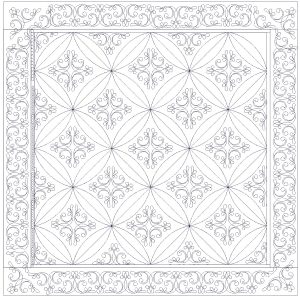
I did a lot of playing around with this…different sizes, different arrangements, and different colour ways (EQ8 has a whole range of Aurifil thread colours in their thread library).
I love the EQ8 program as it is fairly easy to move things around and you can get a good look at the end product. In addition, I find it very useful in looking at dimensions, i.e., what size my motif should be in this arrangement. If I made it too big it was going to look too busy and crowded, if too small it was going to create a problem in terms of the surrounding open space.
Alternatively, if you had a motif that you liked and wanted to put it into a cathedral window shape, you could draw out your cathedral window and trace your motif into it or, even easier – you could use Cindy Needham’s Ultimate Shape stencils which makes that job superfast. All you do is mark your shape and off you go…
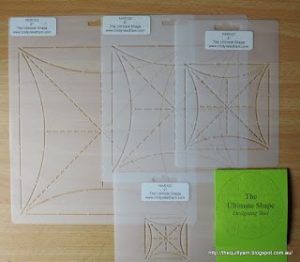
Having the basic framework sorted out, I decided to put some feathers into the melon shape.
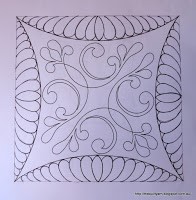
My first attempts at the design with the feathers oriented in different ways.
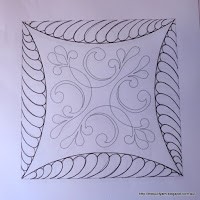
I made some photocopies of this initially and cut out the squares to see what I liked better.

After all of this I started to stitch out the motif and surrounding plumes to get a bit of a sense of how this would work, i.e., would I work freehand, use rulers, trace the motif?
I also tried different threads and batting, getting a bit of a feeling for the design. I stitched this out about four times and noticed that I needed to do a little bit more work on aligning the motif.
I went back to the EQ8 program and edited the motif, drawing in some diagonal lines for alignment in the center, and also adjusted the size of the motif just by a tad to allow for a bit more space around the curve.
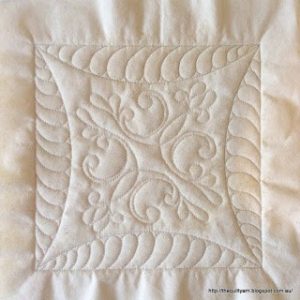
As I was planning to stitch this out on very dark grey (charcoal) fabric, I was thinking that I would only use minimal marking.
I decided to use Cindy Needham’s Shape Stencil to get the framework down, then use rulers to stitch out the framework first. The curve of my ruler did not magically correspond with the Ultimate Shape; however, this did not matter as the Ultimate Shape was giving me the points to align my ruler.
The curvature of my ruler was slightly bigger than the Ultimate Shape curvature (hence I had to do some additional adjusting of the size of the motif in EQ8). The motif was going to be pounced on using Golden Threads (quilt marking) paper (having stitched out the motif without thread onto the paper first).
The feathers were to be stitched using some semi-marking, i.e., just lightly drawing in the feather tops, so I could follow this and have the same number of plumes on each side and in each melon shape.
Next step was to draw this out on my trusted IKEA paper (love that paper roll) using Cindy Needham’s stencil to align the motif and roughly drawing in the plumes.
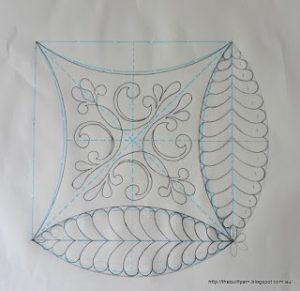
You can see that the ruler I was going to use to quilt the curve was slightly more curved than the shape (drawn in blue). I used this drawing to make the stencil (including the registration lines) for the motif on Golden Threads paper having made sure that it neatly fitted in the space.
You can see that the melon shape was slightly smaller than the ruler that I was going to use but having drawn in the feathers I could see that this was going to work by just extending the feathers slightly outwards.
…and this was only the beginning! If you are thinking that this is a bit obsessive, you are absolutely right. However, I have learnt my lesson of being unprepared in the midst of months and months of stitching when you arrive at the point of…hmmm, that does not work…not a good feeling!
This wholecloth quilt took much longer than originally anticipated and was at one stage almost in danger of becoming a UFO. Lots of things needed tweaking and I did find out that the seemingly endless repetition was wearing me down, however I was able to eventually finish it off and it looked just like I had envisioned it.
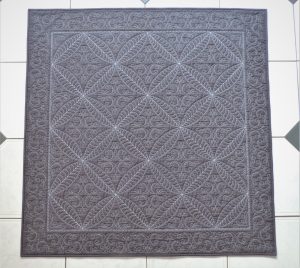
This is just one way of approaching a wholecloth quilt.”
About the Author: I have been quilting since 2006, initially being drawn to the craft by those colourful, scrappy types of quilts. This has not changed much. I am very much a traditional quilter liking all things scrappy and preferring the more repetitive, geometric types of quilt layouts. However, over the last seven years I have also discovered (and subsequently become addicted to) freemotion quilting, so when I am not designing and piecing together new quilts, I am usually working on wholecloth quilts.
If you want to hear and see more of my exploration around this machine and/or have an interest in freemotion quilting, please visit my blog on https://thequiltyarn.blogspot.com/
I hope this inspires you too, and that you now have a fuller understanding of just what goes into making these stunning wholecloth quilts next time you see one at a Show.
Enjoy your week!

PS. If you don’t want to draw up your own wholecloth quilt, you can always cheat! The title image above is from The Stencil Company (https://www.quiltingstencils.com/Preprinted-Wholecloth_c_80.html) and they have a large range of pre-printed wholecloth quilt designs, ranging from 16 inch squares to 108 inch quilts!
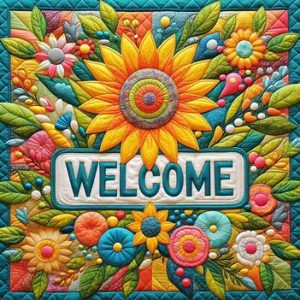

The quilt is beautiful! I made quite a few myself and planned a few months on each. And spend about 8 – 9 months on each as I hand quilted them.
Wow! That is a labour of love and I’m sure well worth it.